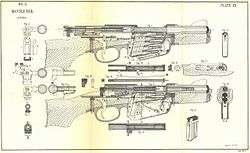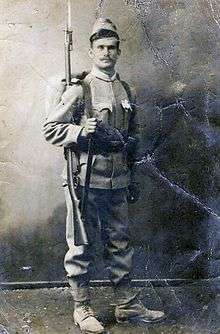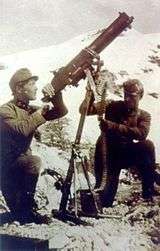Mannlicher M1888
The Repeating Rifle Muster 1888 better known as Mannlicher M1888 was a bolt-action rifle used by several armies from 1888 to 1945. Derived from the M1885 and later M1886 models, it was Ferdinand Mannlicher's third rifle that utilized the "enbloc clip".
It was succeeded by the Mannlicher M1895 as the standard service rifle of the Austro-Hungarian Army. The M95 uses a more secure rotating-bolt, in contrast to the M88's wedge-lock bolt.
History

The M1888 was a direct and immediate descendant of the M1886 Austrian Mannlicher. This rifle too was a straight-pull, bolt-action, box magazine repeater. As early as the beginning of production of the M1886 the need and desirability for a small-bore rifle was evident. This rifle is virtually identical to its predecessor but for chambering a newly designed 8 mm cartridge, loaded originally with black powder and denominated 8×52mmR.

M1888-90 rifle
Shortly thereafter, the M88 cartridge was converted to semi-smokeless powder. The new cartridge was designated 8mm M.1890 scharfe Patrone and its dimensions were 8×50mmR. The sights of existing black powder 8mm Mannlicher rifles were converted to accommodate semi-smokeless ammunition by the functional arrangement of screw mounting re-graduated sideplates onto the outsides of the existing rear sight walls. The converted rifles were denominated M.88–90.
M1890 rifle
When in 1890 semi-smokeless powder became available, manufacture of rifles with a longer and thus stronger chamber and modified sights began. Although the smokeless powder filled M.93 8×50mmR cartridge can be used in this rifle, the generated pressure at 40,000 psi (275.8 MPa) is marginal, as the wedge-lock bolt system this rifle uses was originally designed to be shot with less potent black powder filled 11×58mmR ammunution.
Kuaili 1888 Kiangnan Rifle 7.62x55
China also used this rifle extensively during the Qing dynasty and the Republican era. China first bought Mannlicher 88 rifles before the First Sino-Japanese War in 1894–1895 and after that started production of the unlicensed Kuaili 1888 Kiangnan copy.[13][14][15][16]
Users
.svg.png)




.svg.png)
.svg.png)


.Svg.png)
.svg.png)
.svg.png)
.svg.png)

.svg.png)

_crowned.svg.png)
.svg.png)

.svg.png)

.svg.png)
.svg.png)
.svg.png)
.svg.png)

.svg.png)


References
- 1 2 "Fucile Mannlicher 1888". Euroarms.net. Retrieved 2018-07-24.
- 1 2 citation?
- ↑
- ↑ "Broń strzelecka polskiego wojska w wojnie polsko-bolszewickiej". ossow1920.pl.
- 1 2 "Weapons Of The Greco-Turkish War Part 1Guns Magazine.com - Guns Magazine.com". gunsmagazine.com.
- 1 2 3 4 5 6 "M88/90 Mannlicher find. AOI and British?". forums.gunboards.com.
- ↑ Nicolle, David (20 July 2012). "The Italian Invasion of Abyssinia 1935–36". Bloomsbury Publishing – via Google Books.
- ↑ Joseph, Frank (6 May 2010). "Mussolini's War: Fascist Italy's Military Struggles from Africa and Western Europe to the Mediterranean and Soviet Union 1935-45". Helion and Company – via Google Books.
- ↑ http://www.carbinesforcollectors.com/spanishcivilwar1.html
- 1 2 "Part I of the greek civil war the first battles of the "cold war": partisan groups in Greece were as eager or more to fight each other as the Germans. Even before the Nazis were gone, civil war was underway. - Free Online Library". www.thefreelibrary.com.
- ↑
- ↑ "Вход". gunbg.com.
- ↑ "Chinese made Straight Pull". forums.gunboards.com.
- ↑ "Armaments of China and Siam to 1949 Part 1 - Axis History Forum". forum.axishistory.com.
- ↑
- ↑ "Info" (PDF). www.mh.sinica.edu.tw.
- ↑ "6 Rifles Used by the Afrikaners During the Second Boer War". 17 April 2017.
- ↑ Robert W.D. Ball (2 August 2011). Mauser Military Rifles of the World. Gun Digest Books. p. 127. ISBN 1-4402-1544-8.
- ↑ "Antique 1886 Austrian Chinese Marked". www.aagaines.com.
- ↑ Philip S. Jowett (2010). Chinese Warlord Armies, 1911–30. Osprey Publishing. pp. 43–. ISBN 978-1-84908-402-4.
- ↑ John Walter (25 March 2006). Rifles of the World. Krause Publications. pp. 263–271. ISBN 0-89689-241-7. Retrieved 8 September 2014.
- ↑ "Small arms of the Deutscher Volkssturm part I: Nazi leaders, many of whom already had their tickets punched for Argentina, preached last-ditch resistance to the German people, and provided a motley assortment of tools for the purpose. - Free Online Library". www.thefreelibrary.com.
- ↑ "Israeli Small Arms IDF issue weapons [Archive] - UZI Talk Forums". www.uzitalk.com.
- ↑ {{cite web|url=https://forums.gunboards.com/showthread.php?659665-Mannlicher-88-90-stock-markings
- ↑ http://www.hungariae.com/Mann95It.htm
- ↑ Philip Jowett (20 March 2012). Armies of the Balkan Wars 1912-13: The priming charge for the Great War. Osprey Publishing. p. 24. ISBN 978-1-78096-528-4.
- ↑ "Tribute to Michael Kreca: The Rifles of Yugoslavia and Serbia". tributetomichaelkreca.blogspot.cz.
- ↑ "Bayonets of Siam (Thailand)". worldbayonets.com.
- ↑ "Siamese use of Mannlicher rifles and carbines". forums.gunboards.com.
- ↑ "Siamese Thai: Military Rifle cartridges. - Free Online Library". www.thefreelibrary.com.
- ↑ de Quesada, Alejandro (20 Jan 2015). The Spanish Civil War 1936–39 (2): Republican Forces. Men-at-Arms 498. Osprey Publishing. p. 38. ISBN 9781782007852.
- ↑ "Small arms of the Spanish Civil War" (PDF). www.forgottenweapons.com.
- ↑ ""AOI"-marked Mannlicher M1888 and the Meaning of "St. 91"". forums.gunboards.com.
- "8 x 50 R Mannlicher - www.militaryrifles.com/Austria/88Mann.htm". militaryrifles.com. Retrieved 22 November 2013.
| Wikimedia Commons has media related to Mannlicher M1888. |
